 Sebaceous cysts are common lesions and derive from the hair follicle. They are filled with creamy keratinous debris – layers of skin cells interspersed with keratin.
Sebaceous cysts are common lesions and derive from the hair follicle. They are filled with creamy keratinous debris – layers of skin cells interspersed with keratin.
Ganglion cysts are benign, fluid-filled soft tissue masses commonly seen in the foot.
If a lesion becomes painful or rubs on the shoe, excision may be recommended.
Morton’s neuroma surgery
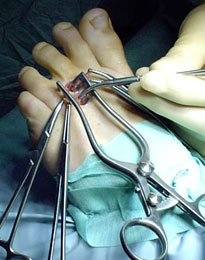 Morton’s’ neuroma describes a trapped digital (toe) nerve that swells and becomes chronically painful.
Morton’s’ neuroma describes a trapped digital (toe) nerve that swells and becomes chronically painful.
Wearing tight shoes or having an abnormal gait pushes the metatarsals together squeezing the nerves between them, and this friction causes the nerve to enlarge. Symptoms of a neuroma vary but may include sharp, tingling or burning sensations that radiate to the toes.
Steroid therapy would generally be attempted first. Those lesions that do not respond to injection therapy may require surgical excision.
Sub ungual exostectomies
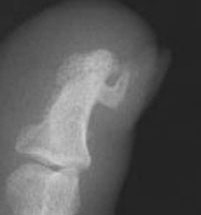 The foot is a common site for the formation of lumps and bumps.
The foot is a common site for the formation of lumps and bumps.
Exostoses (bone spurs) usually form in the foot as a result of localized acute or a chronic injury.
They can occur under the nail and are often misdiagnosed as an ingrown toenail. They can be very painful, particularly in shoes, and may require surgical debridement.
Hammer and mallet toe correction
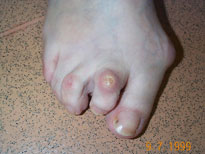 Lesser toe deformities are a major cause of pain and discomfort for many people. A significant proportion of the elderly receive repetitive episodes of palliative chiropody/podiatry to keep the corns and callus associated with these toe deformities comfortable. Unfortunately, although this is excellent at providing temporary relief, unless the toes are maintained in a corrected position, long-term relief from pain is not likely. Surgery straightens the digits, thereby removing the pressure sites responsible for the painful skin lesions.
Lesser toe deformities are a major cause of pain and discomfort for many people. A significant proportion of the elderly receive repetitive episodes of palliative chiropody/podiatry to keep the corns and callus associated with these toe deformities comfortable. Unfortunately, although this is excellent at providing temporary relief, unless the toes are maintained in a corrected position, long-term relief from pain is not likely. Surgery straightens the digits, thereby removing the pressure sites responsible for the painful skin lesions.
Metatarsal surgery for plantar corns
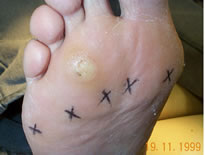 Tailor’s 5th metatarsal – toe deformity is a condition that develops slowly and results from the gradual dislocation of the joint which has become unstable when walking. There are many contributory causes including being flatfooted or wearing ill-fitting shoes.
Tailor’s 5th metatarsal – toe deformity is a condition that develops slowly and results from the gradual dislocation of the joint which has become unstable when walking. There are many contributory causes including being flatfooted or wearing ill-fitting shoes.
Metatarsal heads that are out of line (dropped or elongated) are often congenital deformities. Many patents suffer from corns under the ball of the foot because of this. Breaking and re-setting the bone to take pressure off the ball of the foot, where the pressure is highest, can be effective in selected cases.
Surgery for hallux limitus (arthritis)
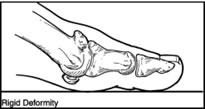 The joint of the big toe takes more weight than any other foot joint in the propulsive phase of gait and is more likely to be affected by osteoarthritis, a condition resulting from excessive wear and tear. Long metatarsal bones and flat footedness are also factors.
The joint of the big toe takes more weight than any other foot joint in the propulsive phase of gait and is more likely to be affected by osteoarthritis, a condition resulting from excessive wear and tear. Long metatarsal bones and flat footedness are also factors.
Arthritis of the big toe joint is so common it has its own name – hallux limitus.
It can be treated surgically by cutting excess bone away or by permanently fusing or removing the joint.
Surgery for hallux valgus (bunion)
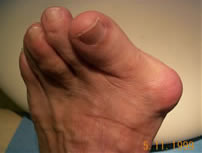 Hallux valgus is a condition that develops slowly and results from the gradual dislocation of the joint, which has become unstable when walking. There are many contributory causes including being flatfooted or wearing ill-fitting shoes. There is also a hereditary link.
Hallux valgus is a condition that develops slowly and results from the gradual dislocation of the joint, which has become unstable when walking. There are many contributory causes including being flatfooted or wearing ill-fitting shoes. There is also a hereditary link.
Bunion surgery aims to correct the structural deformity and improve joint function. Typically I have to shave the extra bone away and break/reset the metatarsal.
Haglund’s deformity
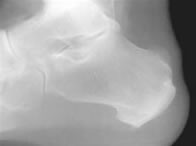 This condition is also known as “pump bumps”, where extra bone forms of the back of the heel from shoe pressure.
This condition is also known as “pump bumps”, where extra bone forms of the back of the heel from shoe pressure.
Resection of bone is required for some patients.
Plantar fasciitis
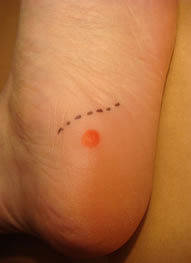 If after a long period of failed conservative care, including steroid therapy, a patient continues to suffer from plantar fasciitis, they may require a surgical release (cutting) of the plantar fascia.
If after a long period of failed conservative care, including steroid therapy, a patient continues to suffer from plantar fasciitis, they may require a surgical release (cutting) of the plantar fascia.
This is done through a small incision to cut and release the tightness in the ligament. A heel spur, if present, is rarely the actual problem. I also use the TOPAZ procedure which is a minimally invasive option giving very good results for selected patients.